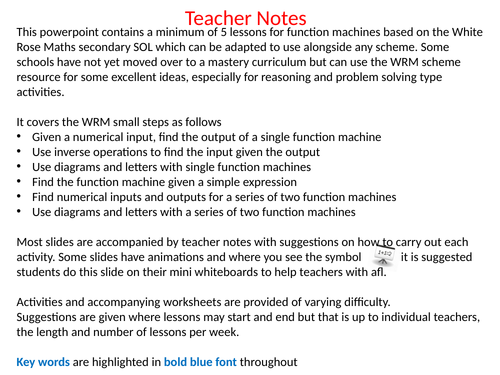












This unit of work on function machines contains at least 5 lessons, a fully animated powerpoint, worksheets and activities in a mastery style approach to teaching. Suggested activities are given for use of afl (eg miniwhiteboards), the use of manipulatives where appropriate and also provides suggestions for carrying out each slide or activity. This work has been put together from the planning I have done from the White Rose Maths scheme and can also be found in the work I have uploaded for week 2 and week 3. (IF YOU ALREADY HAVE PURCHASED THESE, YOU CAN PUT THEM TOGETHER YOURSELF AND THERE WILL BE NO NEED TO BUY THIS RESOURCE).
It contains at least 5 lessons worth of work depending on the class and age of students, length of lesson and time allowed to teach it. Suggestions are given where lessons may start and end but that is up to individual teachers, the length and number of lessons per week.
Whilst I prefer the WRM small steps and the order they are teaching things, I also recognise that not all schools are following the WRM scheme. Some schools have not yet moved over to a mastery curriculum but can use the WRM scheme for some excellent ideas, especially for reasoning and problem solving type activities. Staff have asked me to put topics together from the WRM scheme so that the work can be used alongside other schemes and other year groups and for revision. If you decide to use this with KS4, feel free to change the images to suit an older audience (obviously ensuring you own the images for copyrite purposes). I personally find that it isn’t necessary to change images but that is personal preference.
It covers the WRM small steps as follows
• Given a numerical input, find the output of a single function machine
• Use inverse operations to find the input given the output
• Use diagrams and letters with single function machines
• Find the function machine given a simple expression
• Find numerical inputs and outputs for a series of two function machines
• Use diagrams and letters with a series of two function machines
I hope you find it useful :-)
Something went wrong, please try again later.
This resource hasn't been reviewed yet
To ensure quality for our reviews, only customers who have purchased this resource can review it
Report this resourceto let us know if it violates our terms and conditions.
Our customer service team will review your report and will be in touch.